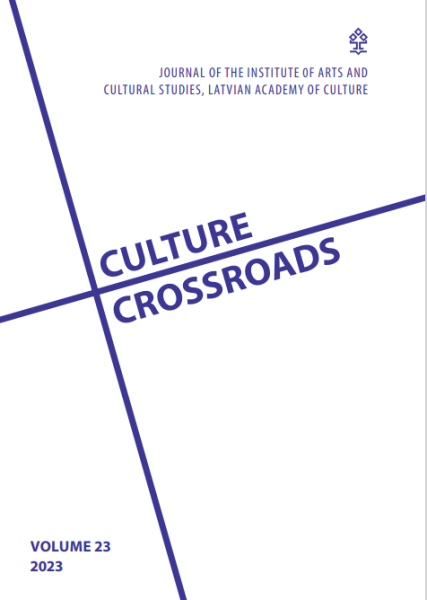HOW TO NETWORK CULTURE: THE ANALYSIS OF THE ECOSYSTEM OF LATVIAN MUSIC FIELD
DOI:
https://doi.org/10.55877/cc.vol23.405Keywords:
social network analysis, culture network, ecosystem, art worlds, music field, the sociology of artsAbstract
The study on the ecosystem of the Latvian music field was carried out within the framework of the CARD project (“the Cultural Capital as a Resource for Sustainable Development of Latvia”) implemented by the Institute of Arts and Cultural Studies of the Latvian Academy of Culture (LAC). One of the tasks of the CARD project was to analyse the cultural ecosystem of Latvia and identify its operator groups, their relationships, and impacts in order to assess the resources of the arts and cultural capital in Latvia [LAC 2020]. Based on initial research, it was suggested to focus on a smaller-scale ecosystem and a specific sub-sector [Laķe, Kunda & Tjarve 2022]. Therefore, this article examines the case of the Latvian music field within the cultural ecosystem of Latvia, as it encompasses a wide range of diverse operator groups. The key theoretical concept used in the research is “ecosystems” – the idea of culture as an ecology that reveals a larger system in a non-hierarchical way [Holden 2015]. In the sociology of art, perceiving culture as a larger system with many equal components is not new; for instance, Howard Becker’s art worlds are based on networks and the distribution of key resources within them [Becker 1974; 1982]. John Holden’s concept of the ecology of culture provides further methodological tools to analyse cultural networks within an ecosystem. The approach suggested by Holden is social network analysis (SNA) [Holden 2015]. While in theory, social network analysis (SNA) holds potential benefits for studying a cultural ecosystem, empirical studies on its application for measuring a cultural ecosystem and its associated limitations remain incomplete. The aim of the paper is to analyse the advantages and limitations of studying a cultural ecosystem using SNA. Two research questions are set: (1) How to analyse the ecosystem of Latvian music field and identify the main operator groups and their relationships? (2) What are the advantages and limitations of employing SNA to study the ecosystem of the Latvian music field? The results contribute to advancing methodological skills in both studying cultural ecosystems and developing SNA in the cultural field.
Downloads
References
Barabasi, Albert-Laslo. (2012). Network Science. Available: http://barabasilab.neu.edu/networksciencebook/ (viewed 24.02.2023.)
Barker, V. (2019). The democratic development potential of a cultural ecosystem approach. Journal of Law, Social Justice and Global Development, No. 24, pp. 86–99.
Becker, H. (1982). Art Worlds. Berkley: University of California Press.
Becker, H. (1974). Art as Collective Action. American Sociological Review, Vol. 39, no. 6., pp. 767–776.
Bottero, W., & Crossley, N. (2011). World, Fields and Networks: Becker, Bourdieu and the Structures of Social Relations. Cultural Sociology, vol. 5, no. 1, pp. 99–119.
Bourdieu, P. (1993). The Field of Cultural Production. Columbia University Press.
Bourdieu, P., & Wacquant, L. J. D. C. (1992). An Invitation to Reflexive Sociology. University of Chicago Press.
Crossley, N., McAndrew, S., and Widdop, P. (eds.) (2011). Social Networks and Music Worlds. Routledge Advances in Sociology, 1st ed. Routledge.
Emirbayer, M., and Goodwin, J. (1994). Network Analysis, Culture, and the Problem of Agency. The American Journal of Sociology, vol. 99, no. 6, pp. 1414–1454.
Holden, J. (2008). Democratic Culture. London: Demos.
Holden, J. (2015). The Ecology of Culture. Arts and Humanities Research Council.
Hoppe, B., and Reinelt, C. (2010). Social network analysis and the evaluation of leadership networks. The Leadership Quarterly, vol. 21, pp. 600–619.
Krebs, V. (2013). Social Network Analysis, A Brief Introduction. Available: http://www.orgnet.com/sna.html (viewed 12.03.2023.)
Laķe, A., Tjarve, B., & Grīnberga, L. (2015). Measuring Social and Economic Impact of Large Scale Cultural Events: A Social Network Analysis. Culture Crossroads, vol. 7, pp. 96–110.
Laķe, A., Kunda, I., & Tjarve, B. (2022). Theoretical Approaches and Methodological Challenges in the Study of the Cultural and Creative Ecosystem. Letonica, vol. 46, pp. 14–37.
Latvian Academy of Culture (2020). Cultural capital as a resource for sustainable development of Latvia/CARD. Available: https://lka.edu.lv/en/research/research-projects/state-research-programmes/cultural-capital-resource-sustainable-development-latviacard/ (viewed 29.04.2023.)
Marin, A., & Wellman, B. (2011). Social Network Analysis: An Introduction. In: J. Scott & P. J. Carrington (eds.). The SAGE Handbook of Social Network Analysis. SAGE, pp. 11–25.
Martin, P. J. (2006). Musicians’ Worlds: Music-Making as a Collaborative Activity. Symbolic Interaction, vol. 29, no. 1, pp. 95–107.
Muktupāvela, R., & Laķe, A. (zin. red.) (2018). Dziesmu un deju svētki. Tradīcijas anatomija. Rīga: Jāņa Rozes apgāds.
Newman, M. (2010). Networks: An Introduction. Oxford, New York: Oxford University Press.
Scott, J. (2012). What is Social Network Analysis? London: Bloomsbury Academic.
Sillamaa, V. (2023). The sound of policy making: how ideas and discourse shape music policy. Master’s thesis. Tallin University of Technology, School of Business and Governance. Available: https://digikogu.taltech.ee/en/Download/fadf05c9-5ea2-4733-b4cb-9ac494935737/Poliitikakujundamiseklakuidasideedjadiskurs.pdf (viewed 12.09.2023.)
Tabassum, S., Pereira, F. S. F., Fernandes, S., & Gama, J. (2018). Social Network Analysis. An Overview. WIREs Data Mining Know. Discov. E1256.
Tjarve, B. (2019). Country profile Latvia. Association of the Compendium of Cultural Policies and Trends, Compendium of Cultural Policies and Trends, 20th ed. Available: https://www.culturalpolicies.net/wp-content/uploads/pdf_full/latvia/Full-country-profile_Latvia.pdf (viewed 12.09.2023.)
Tsujimoto, M., Kajikawa, Y., Tomita, J., Matsumoto, Y. (2018). A review of the ecosystem concept – Towards coherent ecosystem design. Technological Forecasting & Social Change, no. 136, pp. 49–58.
Downloads
Published
Issue
Section
License
Copyright (c) 2023 Culture Crossroads

This work is licensed under a Creative Commons Attribution 4.0 International License.


